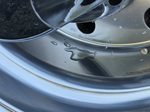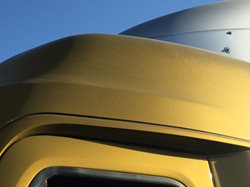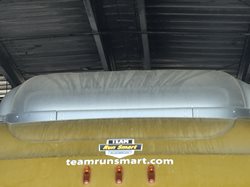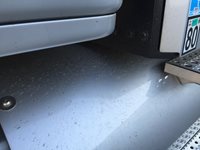 With my new CNG-powered Cascadia having a custom roof cap attached, I began to wonder how I might look into its performance in relation to fluid dynamics, in particular its aerodynamic properties. With no wind tunnel at my disposal, I decided it might be best to look into the fluid properties of liquid around the newly
With my new CNG-powered Cascadia having a custom roof cap attached, I began to wonder how I might look into its performance in relation to fluid dynamics, in particular its aerodynamic properties. With no wind tunnel at my disposal, I decided it might be best to look into the fluid properties of liquid around the newly  installed roof cap. Of course being in Southern California, in the middle of a drought nonetheless, it was not going to be an easy task to observe liquid flow around the cap either. With a lack of rain, it was a quick glance against the glare of the sun one day that offered a glimpse into the airflow efficiency of the newly installed cap and several other features of the truck.
installed roof cap. Of course being in Southern California, in the middle of a drought nonetheless, it was not going to be an easy task to observe liquid flow around the cap either. With a lack of rain, it was a quick glance against the glare of the sun one day that offered a glimpse into the airflow efficiency of the newly installed cap and several other features of the truck.
 With warm days and cool nights here lately, it is a common sight to find a rather annoying layer of dew covering my truck on most mornings. There is nothing quite like a thin layer of dew and a dirt parking lot to make a clean truck look its worst in a matter of just a couple days! Wiping it off of my windshield and mirrors has become a common part of my morning pre-trip inspections now prior to going about my day. With some time to kill at a customer of mine, waiting on another truck to be loaded before mine, I noticed against the glare of the sun just how dirty the top of my truck had got from the dew-drenched mornings. Then it hit me that the streaks of dirt were actually dewdrops being pushed by the air as I took off from my yard each morning and were a prime example of the aerodynamic properties I had been curious about examining!
With warm days and cool nights here lately, it is a common sight to find a rather annoying layer of dew covering my truck on most mornings. There is nothing quite like a thin layer of dew and a dirt parking lot to make a clean truck look its worst in a matter of just a couple days! Wiping it off of my windshield and mirrors has become a common part of my morning pre-trip inspections now prior to going about my day. With some time to kill at a customer of mine, waiting on another truck to be loaded before mine, I noticed against the glare of the sun just how dirty the top of my truck had got from the dew-drenched mornings. Then it hit me that the streaks of dirt were actually dewdrops being pushed by the air as I took off from my yard each morning and were a prime example of the aerodynamic properties I had been curious about examining!
 A dirty truck may not be the first place some would think to look at when thinking about aerodynamics. When you think about it though, it makes perfect sense to examine the fluid properties of things like rain spray and dewdrops, since water tends to behave similar to air in its flow over the surface of an object. I always remember seeing dirty road spray down the sides of trailers after a rainstorm, which now that I think about it, is a shining example of where the air is directing the water as the truck and trailer forge down the highway during inclement weather. So the next time you see a layer of dirt on your truck, us it
A dirty truck may not be the first place some would think to look at when thinking about aerodynamics. When you think about it though, it makes perfect sense to examine the fluid properties of things like rain spray and dewdrops, since water tends to behave similar to air in its flow over the surface of an object. I always remember seeing dirty road spray down the sides of trailers after a rainstorm, which now that I think about it, is a shining example of where the air is directing the water as the truck and trailer forge down the highway during inclement weather. So the next time you see a layer of dirt on your truck, us it  as a research tool to find out where air might be hanging up on your rig, helping you to choose where your aero inefficiencies might be found. Not only did my dirty truck unveil that the air was flowing in a perfect pattern over the top of the new cap, but it helped me better understand how the air hangs up going around my CNG fuel cabinet as well. Being that the newer CNG cabinets have even more aerodynamic improvements over the generation I have, I would be curious to see one of the newer models after a dirty rainstorm as well, to witness if these inefficiencies found in mine have been reduced as well!
as a research tool to find out where air might be hanging up on your rig, helping you to choose where your aero inefficiencies might be found. Not only did my dirty truck unveil that the air was flowing in a perfect pattern over the top of the new cap, but it helped me better understand how the air hangs up going around my CNG fuel cabinet as well. Being that the newer CNG cabinets have even more aerodynamic improvements over the generation I have, I would be curious to see one of the newer models after a dirty rainstorm as well, to witness if these inefficiencies found in mine have been reduced as well!